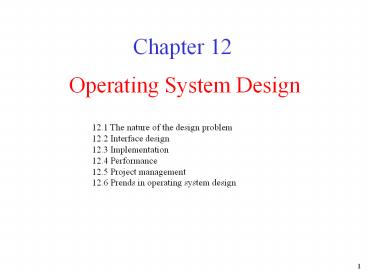Operating%20System%20Design - PowerPoint PPT Presentation
Operating%20System%20Design
Operating System Design 12.1 The ... 12.4 Performance 12.5 Project management 12.6 Prends in ... names Static Versus Dynamic Structures Code for searching the process ... – PowerPoint PPT presentation
Title: Operating%20System%20Design
1
Operating System Design
- Chapter 12
12.1 The nature of the design problem 12.2
Interface design 12.3 Implementation 12.4
Performance 12.5 Project management 12.6 Prends
in operating system design
2
Paradigms (1)
- Algorithmic code
3
Paradigms (2)
- Event-driven code
4
Implementation
Layer
- One possible design for a modern layered
operating system
5
Naming
- Directories are used to map external names onto
internal names
6
Static Versus Dynamic Structures
- Code for searching the process table for a given
PID.
Searching a static table for a pid
7
Hiding the Hardware (1)
- CPU-dependent conditional compilation
8
Hiding the Hardware (2)
- Word-length dependent conditional compilation
9
Space-Time Trade-offs (1)
- A procedure for counting bits in a byte
(a)
A procedure to count the 1 bits in a byte
10
Space-Time Trade-offs (2)
- A macro to count the bits
- A macro to access bit count in a table
(b) Macro to count the bytes (c) Macro to look up
the count
11
Space-Time Trade-offs (3)
- (a) Part of an uncompressed image with 24 bits
per pixel - (b) Same part compressed with GIF, 8 bits per
pixel - (c) The color palate
12
Caching
- Part of an i-node cache
13
Software team Structure
- Mills proposal for populating a 10-person chief
programmer team
14
The Role of Experience (1)
- Traditional software design progresses in stages
15
The Role of Experience (2)
- Alternative design produces a working system
- that does nothing starting on day 1
PowerShow.com is a leading presentation sharing website. It has millions of presentations already uploaded and available with 1,000s more being uploaded by its users every day. Whatever your area of interest, here you’ll be able to find and view presentations you’ll love and possibly download. And, best of all, it is completely free and easy to use.
You might even have a presentation you’d like to share with others. If so, just upload it to PowerShow.com. We’ll convert it to an HTML5 slideshow that includes all the media types you’ve already added: audio, video, music, pictures, animations and transition effects. Then you can share it with your target audience as well as PowerShow.com’s millions of monthly visitors. And, again, it’s all free.
About the Developers
PowerShow.com is brought to you by CrystalGraphics, the award-winning developer and market-leading publisher of rich-media enhancement products for presentations. Our product offerings include millions of PowerPoint templates, diagrams, animated 3D characters and more.































